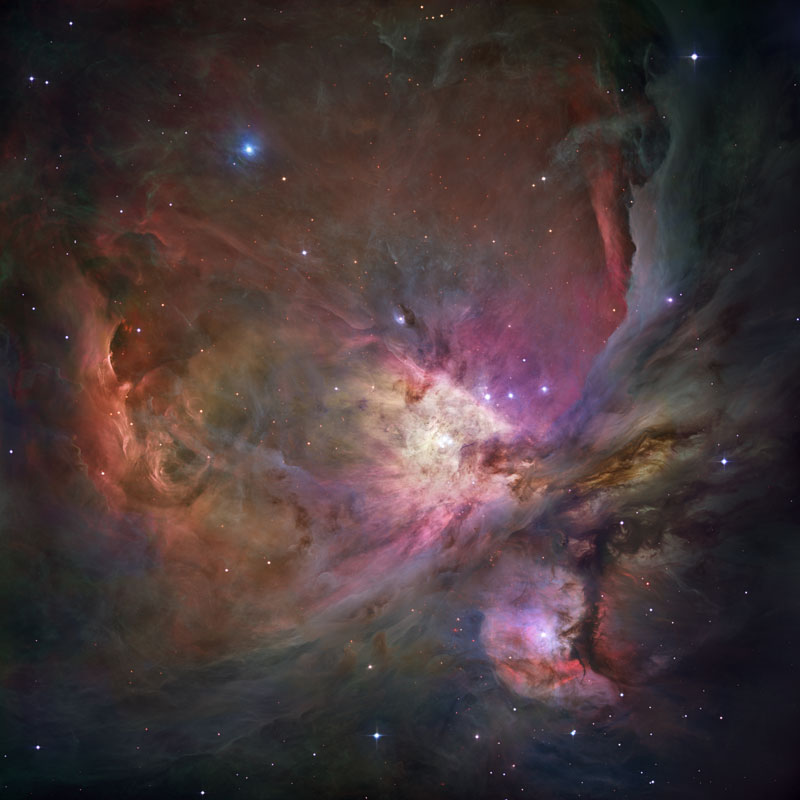







| BOOKS | F. A. Q. | ARTICLES | TALKS | ABOUT KEN | DONATE | BEYOND OUR KEN |
|---|
By Ken Croswell
June 19, 2007

Image of the Orion Nebula by the Hubble Space Telescope [NASA, ESA, Massimo Robberto (Space Telescope Science Institute/ESA), and the Hubble Space Telescope Orion Treasury Project Team.]
Early this year, an astronomer in England reported he had used the spins of stars to determine that the Orion Nebula is much closer to Earth than had been thought. Now astronomers in California have confirmed this result by measuring the parallax of a young star in this famous stellar nursery.
Both studies find that the Orion Nebula is about 1,300 light-years from Earth--over 200 light-years closer than previously thought.
The Orion Nebula is a cloud of gas and dust visible to the unaided eye in the sword of Orion. It has spawned a cluster of more than 3,000 newborn stars, the hottest of which set the nebula's gas aglow.
Karin Sandstrom, Joshua Peek, Geoffrey Bower, Alberto Bolatto, and Richard Plambeck at the University of California at Berkeley studied a T Tauri star--a precursor of a Sunlike star--in the Orion Nebula. Named GMR A, this star is spectral type K5 and would look orange if gas and dust didn't block its light.
 Sandstrom and her colleagues observed radio waves from GMR A
by using the Very Long Baseline Array (VLBA), which consists of ten
radio telescopes in New Hampshire, Iowa, Texas, New Mexico,
Arizona, California, Washington State, Hawaii, and the Virgin
Islands. By combining observations from all these telescopes, the
astronomers obtained precise positions of the star and measured its
parallax.
Sandstrom and her colleagues observed radio waves from GMR A
by using the Very Long Baseline Array (VLBA), which consists of ten
radio telescopes in New Hampshire, Iowa, Texas, New Mexico,
Arizona, California, Washington State, Hawaii, and the Virgin
Islands. By combining observations from all these telescopes, the
astronomers obtained precise positions of the star and measured its
parallax.
Parallax occurs because the Earth orbits the Sun. As a result, astronomers view a star from a slightly different perspective in January than they do in July, so the star's position seems to shift. The closer the star is to Earth, the greater this shift, or parallax.
Sandstrom's team finds that GMR A's parallax is 2.57 ± 0.15 milliarcseconds. (One milliarcsecond is 1/3600000 of a degree--the apparent size of a car on Earth as seen by an observer on the Moon.) This parallax implies a distance from Earth of 1,269 +78-68 light-years.
For comparison, Rob Jeffries at Keele University in England recently used the rotation periods of stars in the Orion Nebula to derive a distance of 1,279 ± 104 light-years. Thus, the two results are in excellent agreement.
The new distance is about 20 percent less than the standard distance astronomers have used for the last quarter century. Therefore, if the new distance is right, the stars in the Orion Nebula emit only about two thirds as much light into space as had been thought.
Furthermore, the new distance means that the Orion Nebula's many pre-main-sequence stars are nearly twice as old as previously estimated. That's because these stars shrink and fade before reaching the main sequence. If the stars emit less light, they must be smaller and thus older than previously thought.
The Orion Nebula is the closest region to Earth that is giving birth to stars of all masses: from hot, high-mass stars that will one day explode as supernovae, to cooler stars like the Sun, to small stars that will shine dimly as red dwarfs and brown dwarfs. In contrast, star-formation regions closer to Earth--such as the clouds of Taurus--are producing only stars with roughly the Sun's mass and below.
Sandstrom and her colleagues will publish their work in The Astrophysical Journal.
Update (September 6, 2007): Astronomers in Germany and the United States have measured the parallaxes of two additional stars in the Orion Nebula. These parallaxes, plus a remeasurement of GMR A's parallax, yield a distance to the Orion Nebula of 1,350 ± 22 light-years.
Ken Croswell is an astronomer and the author of Magnificent Universe and See the Stars, whose January chapter features a large, full-color photograph of the constellation Orion--with the Orion Nebula's position marked.
"Magnificent Universe by Ken Croswell is elegant and eloquent."--Washington Post. See all reviews of Magnificent Universe here.
"Finally! An astronomy guide that the reader can actually follow without being a rocket scientist!" See all reviews of See the Stars here.
| BOOKS | F. A. Q. | ARTICLES | TALKS | ABOUT KEN | DONATE | BEYOND OUR KEN |
|---|